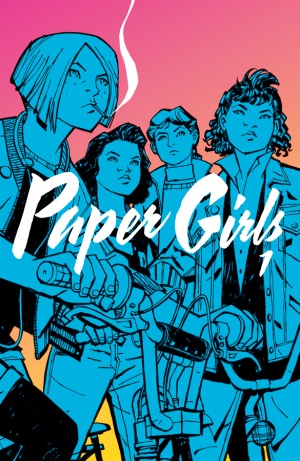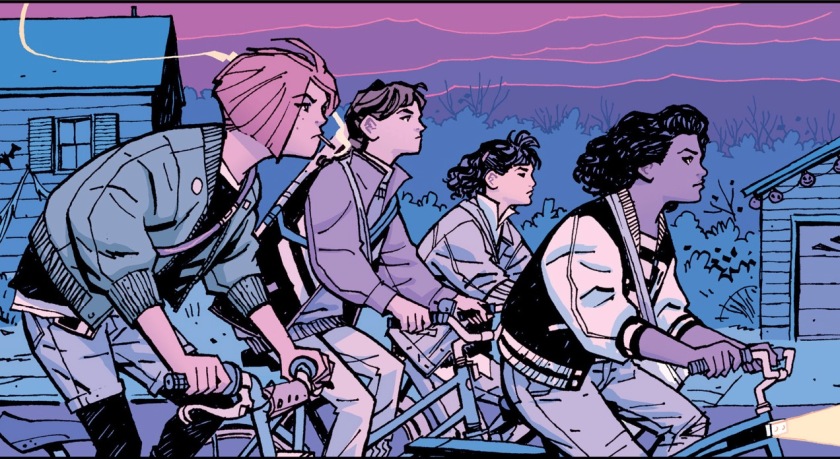
Paper Girls, Vol.1
Image Comics
March 2016
Writer: Brian K. Vaughan
Artist: Cliff Chiang
Colorist: Matt Wilson
Lettering: Jared K. Fletcher
In keeping with the rest of the world, I’m still reeling from the 48-hour trip that was binge watching Stranger Things. That synth-pop lovin’ Goonies meets Lost Boys meets ET masterpiece was MADE for me. When someone mentioned that Paper Girls was basically the comic book/female cast version of the show, I all but sprinted to buy it.
Just the cover had me completely won over. I MEAN, CAN YOU SEE IT?
Paper Girls follows four newspaper delivery girls through the pre-dawn streets of Cleveland, OH. Banding together, these ladies are ready to face whatever comes their way, whether it be bill-evading customers, uninvited male advances, or invading supernatural predators.
What I Loved
The Artwork. I’ll talk about the coloring first, as that was what initially drew me in and carried me through the entire volume. The way Wilson utilizes color is beautiful and spot-on. Many spreads and panels are almost ombre-like in their tonal shifts, utilizing a dusty, muted variation of stereotypical 80’s neons. This was, without a doubt, the most aesthetically pleasing comic I’ve read so far.
Chiang’s drawing was also a major winner here. The characters look like actual adolescent girls (a refreshing change of pace), and the clothing is spot-on, a perfect match for the time period while avoiding cliched trends like leg warmers and side-ponies.
I read recently that late to the game comic readers like myself have a hard time shifting from text-only reading to simultaneous text/image reading – skipping from word bubble to word bubble and ignoring the images in between. I’ve definitely felt this in my reading so far, but I think the artwork and color in Paper Girls helped me bridge that gap. I couldn’t help but pay attention.

I genuinely wanted to cut out entire spreads of this to hang on my wall. I’m assuming that this is frowned upon in the community – akin to highlighting, writing in margins, or dog-earing pages of books (All of which I do. What are you going to do about it? AB-SO-LUTE-LY. NOTHING).
What I Not So Loved
Pacing and Character Development. The four titular characters were each so uniquely different; it’s unfortunate that they seemed to get lost in the shuffle. Paper Girls got a bit bogged down by a constant influx of new characters (human and non-) and I often wished it would slow down a bit. I would have happily read page after page of the girls going around on their bicycles, smoking cigarettes, and putting down school bullies – providing some much-needed character development. This, however, wasn’t the case, and the story quickly moved onto a (still not quite fully realized) supernatural invasion (it’s a wild one).
I’m going to make a major (and much too early) generalization and say that this kind of fast-paced storytelling is just part of the medium, and I’m just not used to it quite yet.
In the end, I finished Paper Girls the same way I finished Stranger Things – pretty confused. Whatever supernatural being reeking havoc on Cleveland is yet to be fully understood by the end of Vol. 1. If that suspense doesn’t get readers itching to read Vol. 2, then the cliffhanger in the final panel will.
Vol. 2 of Paper Girls will be available November 30, 2016 (but you can buy the single issues now if that cliffhanger is just too much to bear).

